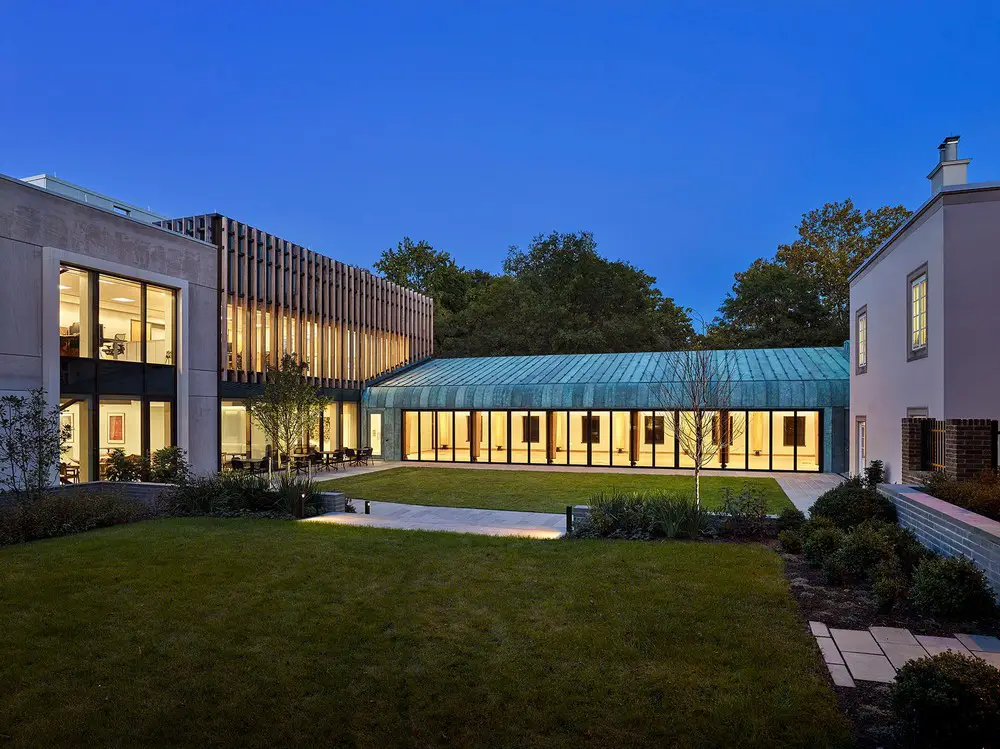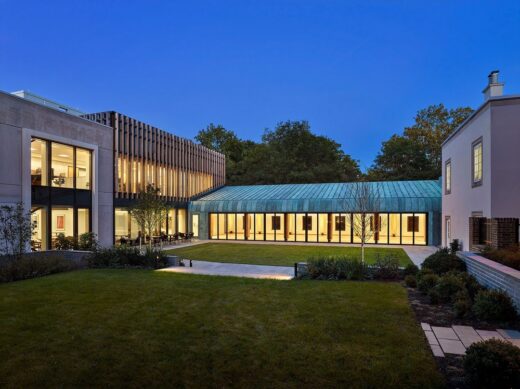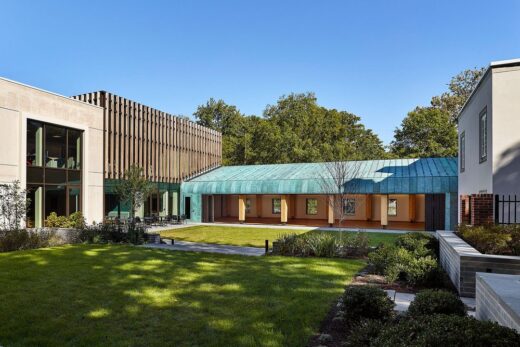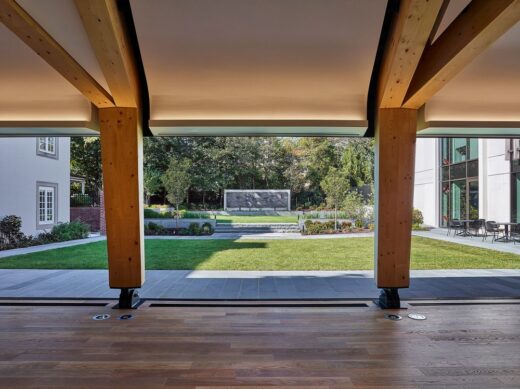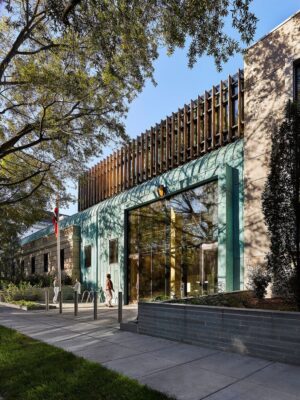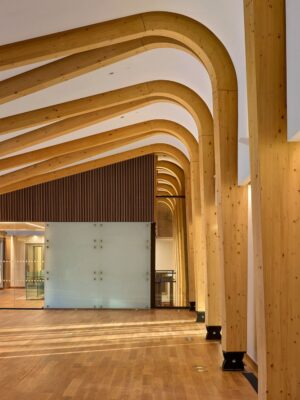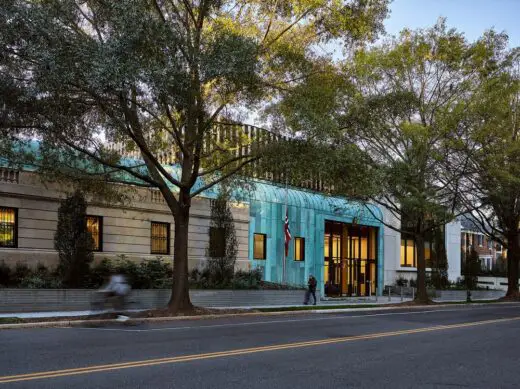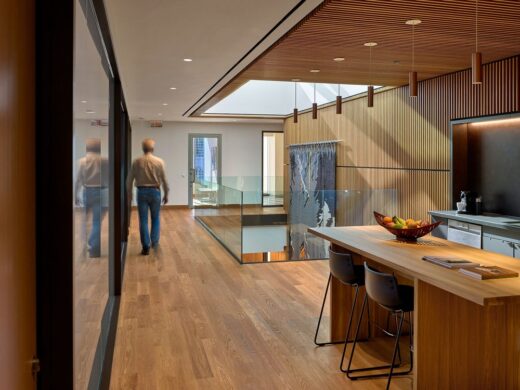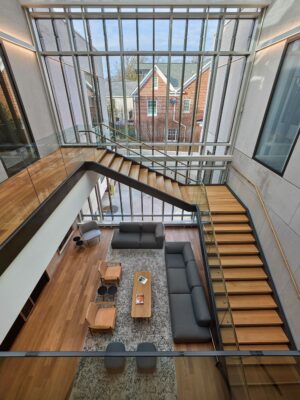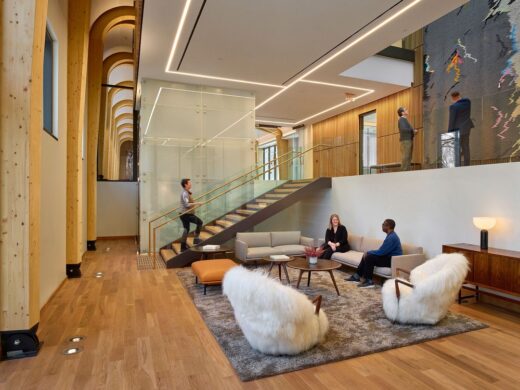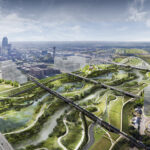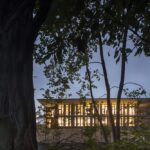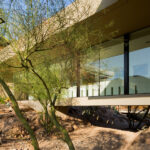Royal Norwegian Embassy, Washington DC Renovation, USA Public Architecture, American Building Photos
Royal Norwegian Embassy in Washington DC
May 12, 2022
Design: Fentress Architects
Location: Washington, D.C., USA
Photos © Alan Karchmer / OTTO
Royal Norwegian Embassy, USA
Established in 1905, Norway’s Embassy is located on the venerable Embassy Row in Washington, DC between the Vice President’s residence and the National Cathedral. It’s 1970-era Chancery recently underwent an 30,000-square-foot expansion and renovation. Fentress Architects designed this essential element of Norway’s largest embassy complex in to be culturally symbolic, architecturally harmonious, modernized, sustainable and universally accessible.
Since architecture can play a profound role in the diplomatic environment, every element of the project was carefully considered: for staff, guests, and diplomatic relations. Four principles guided this effort: Handlekraft (vigor), Arbeidsglede (joy of work), Profesjonalitet (professionalism) and Åpenhet (openness).
“While providing significant functional, accessibility and sustainability upgrades, our architecture makes Norway’s rich heritage visible on one of the most culturally significant streets in the world.”
— Steve White, Principal & Director of the Washington DC Office, Fentress Architects
The result is a transformed Chancery comprised of three elements: a stone shell, a cocoon, and a copper-clad mass timber hull. The mass and forms of the limestone-clad stone shell are deliberately segmented and scaled to show deference to the Ambassador’s residence and blend harmoniously with the historic residential neighborhood. While the vast majority of the existing structure and limestone cladding were retained and restored, strategic interventions were made to the stone façade in order to open-up new views of the garden and public street, block undesired views from neighbors, and introduce generous daylight within.
The wood-finned curtainwall cocoon wraps internal elements including the lobby atrium and Social Hub, as well as extrudes externally to screen rooftop elements. A two-story space, known as the “Social Hub,” is connected by an open stair and functions as a venue for staff to engage in intellectual dialogue and build community.
Diplomatic spaces are demarcated and celebrated with the help of a copper-clad mass timber hull. Wrapped in copper, an open, gracious and accessible new entry to the Embassy results from lowering the original lobby structure seven feet and eliminating an associated obtrusive staircase. Copper cladding recalls Norway’s gift of copper for the Statue of Liberty. Adjacent to the entry is Atlantic Ocean Hall, which incorporates the old garden wall, and for which underutilized courtyard space was captured. Atlantic Ocean features a new mass timber structure that recalls Viking mastery of shipbuilding and woodworking. In rhythm with the historic windows, the structure’s spruce columns alternate in a triangular grid, thereby eliminating the need for additional cross bracing and creating a dramatic, yet intimate space for Norwegian hospitality and diplomacy. The mansard form of the roof is appropriate to the neighborhood and gives the Atlantic Ocean Hall its distinctive shape.
Given that sustainability is a tenet of the Embassy’s mission, it was also a tenet of the design. Reusing existing buildings is inherently more sustainable than new construction; and so, 90-percent of the existing structure was re-used with only 3,500 square feet added. Interventions focused on increasing program area within the existing footprint, enhancing the indoor and outdoor environment, and improving systems performance. For example, previously underutilized areas were converted into flexible, multi-use rooms. Likewise, a spacious staff lunchroom was designed to also accommodate large informal meetings as well as provide food-prep support to Atlantic Ocean Hall and Courtyard functions. Smaller, multi-use spaces are distributed throughout both office wings. Flex spaces such as these, along with open office layouts, more easily accommodate future needs. In fact, all office spaces were completely reconfigured and improved. A cold, dark, north-facing courtyard terrace between the two office wings was glazed-in and now features a social gathering space and coffee bar.
The entry plaza is now flanked by bioswales that harvest rainwater from roofs and gardens, and are planted with native, pollinator-friendly garden species. Atlantic Ocean Hall opens out onto a large, terraced garden with designated areas of structured turf for tented events, a rain garden with native species, flowering perennials, mature trees, and a semi-private Ambassador’s Walk. Additional sustainable strategies included:
• Almost half the site is open space, planted with native and adaptive, pollinator-friendly species. All parking is underground, with electric charging stations for cars and bicycles. All street trees were retained, which are also mature and are considered heritage.
• Bioretention planters and permeable pavements manage all the run-off on-site, eliminating any burden to the Rock Creek watershed. Indoor water use is 25% less than baseline.
• Thermal envelope upgrades, new low-e double-glazing, and fritted skylights result in a projected energy cost savings of 21.8-percent over the ASHRAE-90.1 baseline.
• The wood and copper structures—all of which are capable of being disassembled, reused and recycled—highlight natural materials and promote traditional skills and craftsmanship.
• 2.5-percent of the total value of architectural construction material was spent on sustainably harvested wood.
[Atlantic Ocean Hall, a] year-round, indoor-outdoor space has already hosted climate-focused presentations and events, and turns diplomats and visitors into tree huggers.
— Arild Ravlo Hersleth, Project Manager, Statsbygg
Standby power, durable technology infrastructure, and a robust building enclosure system are among the many elements that reinforce structural resilience within the Chancery. In addition to being amply secure, the Chancery also features an accessible and transparent street presence. An internal elevator connects all levels, restrooms are designed to be gender neutral, and stair landings are textured to assist the vision-impaired.
Further enlivening the spaces, new and repurposed art pieces include: Metamorphosis, a significant larvikite granite sculpture by Knut Steen designed in 1986 and relocated to the garden; and – one of five new, specially-commissioned major installations – the 18-foot long Dreams Ahead, by Ann Cathrin November Høibo, hangs in the lobby atrium space, visible from the public right of way along 34th Street.
In April 2022 the Embassy Renovation Project won its first award from the Washington, DC Chapter of the American Institute of Architects.
About The Embassy
• With a staff of 60, the Embassy in Washington is Norway’s largest.
• The original chancery was built in 1977 as a two-story, limestone-clad structure that contained basement parking, staff offices and diplomat apartments.
• The first structure built on the Embassy grounds was an historic Italianate residence for the ambassador. Completed in 1931, this was also the second foreign service mission to be constructed in the United States on the venerable Embassy Row on Massachusetts Avenue. It is a beautifully articulated expression of early 20th century neo-classical architecture with an Italianate structure that features a symmetrical tripartite arrangement: rusticated base, piano Nobile and hipped roof. Its Indiana-limestone façade includes quoining and an ornamental bracketed cornice. Piano Nobile fenestration consists of pedimented limestone openings with Juliette balcony balustrade. The slate roof is hipped and symmetrical with the façade. Extending from the house to the north, as part of the 34th Street experience, is a rusticated one-story limestone garden wall, which encloses a beautifully manicured landscape.
About Fentress Architects
Fentress Architects – https://fentressarchitects.com/ is a global design firm, which passionately pursues the creation of sustainable and iconic architecture that improves the human environment. As a dynamic organization, Fentress is driven to design, innovate, and exceed client expectations. Since its founding in 1980 by Curtis Fentress, the firm’s portfolio of completed work is valued at over $43 billion, has grown to serve more than 650 million people each year, and has been honored with more than 550 distinctions for design excellence and innovation.
Photography © Alan Karchmer / OTTO
Royal Norwegian Embassy, Washington DC images / information received 120522
Location: Washington, D.C., USA
Architectur in Washington DC
Major District of Columbia Architectural Projects:
Washington DC Architecture Designs – chronological list
Fentress Architects To Design Pentagon 9/11 Memorial Visitors Center, USA
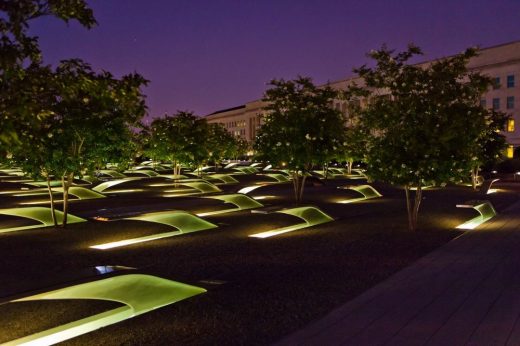
image courtesy of architects
9/11 Pentagon Memorial Visitor Education Center in Arlington
Washington DC Architecture Tours by e-architect
National Presbyterian Church Washington, D.C., 4101 Nebraska Ave NW
Design: Beyer Blinder Belle Architects & Planners
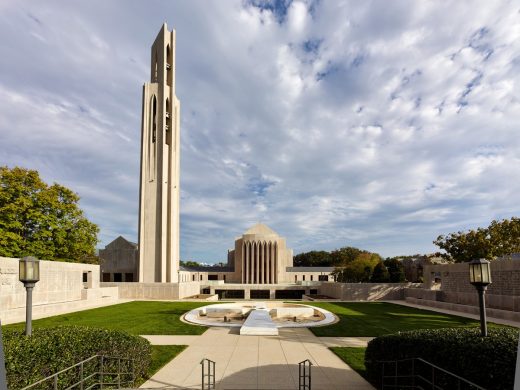
photo : Alan Karchmer
National Presbyterian Church Washington, D.C.
Planet Word Museum Building
Design: Beyer Blinder Belle
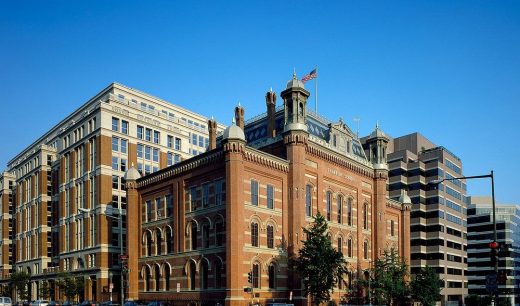
photographs in the Carol M. Highsmith Archive, Library of Congress, Prints and Photographs Division
Planet Word Museum
Washington DC Embassy Building
Apple Store Carnegie Library Building
New Washington Redskins Stadium
American Buildings
Contemporary Architecture in Virginia
Comments / photos for the Royal Norwegian Embassy, Washington DC design by Fentress Architects page welcome

